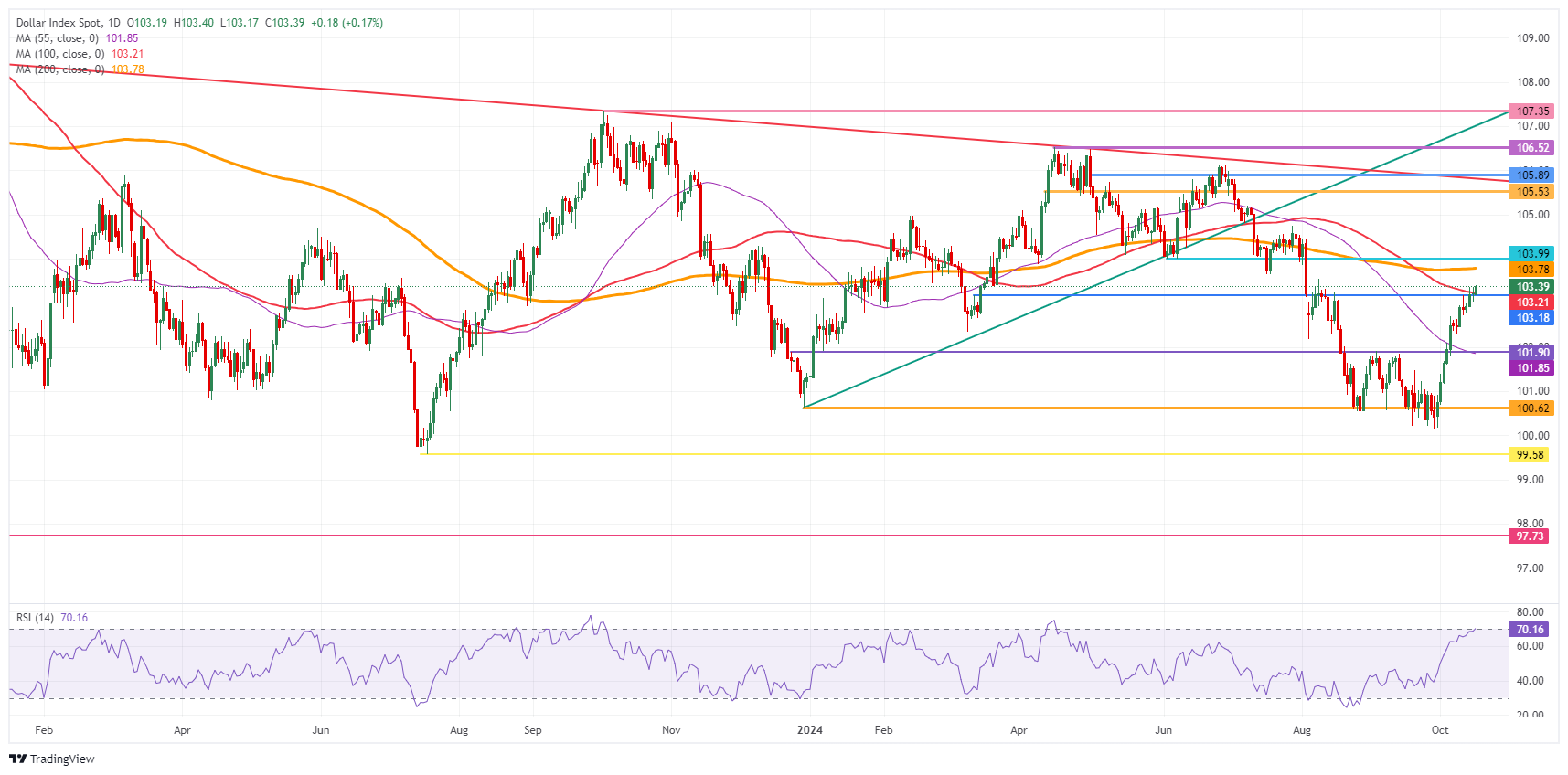- The US dollar strengthens and flirts with a new two-month high.
- Traders are increasing their bets on a Trump victory for the second day in a row.
- The Dollar Index breaks a key level on its way towards 104.00.
The US Dollar (USD) extends its gains on Wednesday after breaking a very strong resistance level on the Dollar Index (DXY). The greenback received an additional boost after former President Donald Trump appeared on Bloomberg television outlining his plans if he wins the Nov. 5 presidential election. Trump made some tough statements on trade, taxes and the Federal Reserve (Fed), which was enough to boost the greenback against most of its major currency pairs, as traders appear increasingly convinced of a victory for the Republican candidate.
The US economic calendar is light on Wednesday, with no data to really move the market and no Fed officials scheduled to speak. Traders are expected to remain cautious ahead of the European Central Bank (ECB) meeting on Thursday.
Daily Market Review: Trump rides on momentum
- During Tuesday’s US session, former President Donald Trump appeared in an interview on Bloomberg. He used the forum to further outline his plans on trade, the US economy and the Fed. His words propelled the US dollar to new two-month highs against the Euro (EUR) and against the Chinese Yuan (CNY). .
- Looking at the calendar, the Mortgage Bankers Association (MBA) Weekly Mortgage Applications were scheduled for 11:00 GMT. Claims fell a staggering 17% after last week’s claims already fell 5.1%.
- At 12:30 GMT, the Import/Export Price Index for September is expected:
- Monthly Export Prices are expected to decline less rapidly, by 0.4%, down from a 0.7% drop in August, while the Monthly Import Price Index is expected to decline further to 0.4 , coming from a negative 0.3% in August.
- Stocks are trading mixed, with Chinese stocks closing substantially lower while Japan rose on the day. European stocks look sluggish while US futures are fairly flat.
- The CME Fed rate expectation for the November 7 meeting shows a 94.2% probability of a 25 basis point rate cut, while the remaining 5.8% are pricing in no rate cut . The chances of a 50 basis point rate cut have been completely ruled out.
- The US 10-year benchmark rate is trading at 4.00%, slightly softer than last week’s high of 4.11% seen on Thursday.
Dollar Index Technical Analysis: The Trump Effect Expands
The US Dollar Index (DXY) is seeing a lot of support and inflows for the second day in a row following former US President Donald Trump’s interview.
Markets are starting to take positions on the assumption that Trump will win the election, which traders seem to associate with a stronger US dollar based on their exposed plans. With the DXY making its way through that difficult 100-day SMA at 103.21, the next level is 103.78 and 104.00.
A double resistance band lies ahead at 103.78, which aligns with the 200-day SMA. After that, there is a small gap before reaching the crucial level at 103.99 and the big figure at 104.00. If Trump starts leading even further in the polls, there could be a quick move towards 105.00 with 105.53 as the first target.
On the downside, the 100-day SMA at 103.21 along with the crucial level at 103.18 now act as support and should prevent the DXY from falling further. With the Relative Strength Index close to overbought territory, a test at this level seems warranted. Further down, the 55-day SMA at 101.85 and the crucial level at 101.90 should prevent any further move lower.
Dollar Index: Daily Chart
The US Dollar FAQs
The United States Dollar (USD) is the official currency of the United States of America, and the “de facto” currency of a significant number of other countries where it is in circulation alongside local banknotes. According to 2022 data, it is the most traded currency in the world, with more than 88% of all global currency exchange operations, equivalent to an average of $6.6 trillion in daily transactions. After World War II, the USD took over from the pound sterling as the world’s reserve currency.
The single most important factor influencing the value of the US Dollar is monetary policy, which is determined by the Federal Reserve (Fed). The Fed has two mandates: achieve price stability (control inflation) and promote full employment. Your main tool to achieve these two objectives is to adjust interest rates. When prices rise too quickly and inflation exceeds the 2% target set by the Fed, the Fed raises rates, which favors the price of the dollar. When Inflation falls below 2% or the unemployment rate is too high, the Fed can lower interest rates, which weighs on the Dollar.
In extreme situations, the Federal Reserve can also print more dollars and enact quantitative easing (QE). QE is the process by which the Fed substantially increases the flow of credit into a clogged financial system. This is an unconventional policy measure used when credit has dried up because banks do not lend to each other (for fear of counterparty default). It is a last resort when a simple lowering of interest rates is unlikely to achieve the necessary result. It was the Fed’s weapon of choice to combat the credit crunch that occurred during the Great Financial Crisis of 2008. It involves the Fed printing more dollars and using them to buy US government bonds, primarily from financial institutions. QE usually leads to a weakening of the US Dollar.
Quantitative tightening (QT) is the reverse process by which the Federal Reserve stops purchasing bonds from financial institutions and does not reinvest the principal of maturing portfolio securities in new purchases. It is usually positive for the US dollar.
Source: Fx Street
I am Joshua Winder, a senior-level journalist and editor at World Stock Market. I specialize in covering news related to the stock market and economic trends. With more than 8 years of experience in this field, I have become an expert in financial reporting.








